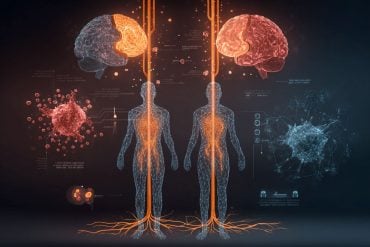Summary: Researchers propose a variety of therapeutic approaches and medications to help combat adult nightmare disorder.
Source: AASM.
A variety of treatment options may be effective for nightmare disorder in adults, according to a position paper from the American Academy of Sleep Medicine (AASM).
The position paper reports that image rehearsal therapy is useful for the treatment of nightmare disorder and nightmares associated with post-traumatic stress disorder (PTSD). Image rehearsal therapy is a technique that involves altering the content of a nightmare by creating a new set of positive images and rehearsing the rewritten dream scenario while awake.
Although evidence was less clear for other treatments, the task force found that a variety of interventions may be used for the treatment of nightmare disorder, including cognitive behavioral therapy, hypnosis, and several prescription medications. In contrast, the task force concluded that the anti-anxiety medication clonazepam and the antidepressant venlafaxine are not recommended for the treatment of nightmare disorder.
“Helpful treatment options are available for adults who are experiencing distress due to nightmares,” said lead author Dr. Timothy Morgenthaler, professor of medicine at Mayo Clinic in Rochester, Minnesota. “The judgment and expertise of a knowledgeable clinician are essential to ensure appropriate treatment selection and effective management of nightmare disorder.”
A task force developed the position paper based on their clinical expertise and a qualitative assessment of the available evidence. The paper was approved by the AASM board of directors and is published in the June 15 issue of the Journal of Clinical Sleep Medicine.
Nightmare disorder involves repeated occurrences of nightmares that cause clinically significant distress or impairment. It affects approximately 4 percent of adults, occurring in isolation or as part of other disorders such as PTSD, and it can significantly impair quality of life. Nightmare disorder also can exacerbate an underlying mental illness, such as depression or anxiety.
“The first step to get help for nightmares is to discuss this concern with a doctor, who may refer you to an accredited sleep center for a comprehensive sleep evaluation by a board-certified sleep medicine physician,” said AASM President Dr. Douglas Kirsch. “Effectively treating nightmare disorder can improve sleep quality, resulting in less daytime sleepiness and improved alertness.”

The position paper includes the following position statements. Positions of “recommended” and “not recommended” indicate that a treatment option is determined to be clearly useful, or ineffective or harmful, for most patients. Positions of “may be used” indicate that the evidence or expert consensus is less clear, either in favor, or against the use, of a treatment option:
- The following therapy is recommended for the treatment of PTSD-associated nightmares and nightmare disorder: image rehearsal therapy.
- The following therapies may be used for the treatment of PTSD-associated nightmares: cognitive behavioral therapy; cognitive behavioral therapy for insomnia; eye movement desensitization and reprocessing; exposure, relaxation, and rescripting therapy; the atypical antipsychotics olanzapine, risperidone and aripiprazole; clonidine; cyproheptadine; fluvoxamine; gabapentin; nabilone; phenelzine; prazosin; topiramate; trazodone; and tricyclic antidepressants.
- The following therapies may be used for the treatment of nightmare disorder: cognitive behavioral therapy; exposure, relaxation, and rescripting therapy; hypnosis; lucid dreaming therapy; progressive deep muscle relaxation; sleep dynamic therapy; self-exposure therapy; systematic desensitization; testimony method; nitrazepam; prazosin; and triazolam.
- The following are not recommended for the treatment of nightmare disorder: clonazepam and venlafaxine.
- The ultimate judgment regarding propriety of any specific care must be made by the clinician, in light of the individual circumstances presented by the patient, accessible treatment options, and resources.
The task force also identified a need for more randomized controlled trials and well-designed comparative efficacy trials to allow for further evaluation of treatments for nightmare disorder.ights at night, and try to get as much light by day as possible.
Source: AASM
Publisher: Organized by NeuroscienceNews.com.
Image Source: NeuroscienceNews.com image is in the public domain.
Original Research: Open access research for “Position Paper for the Treatment of Nightmare Disorder in Adults: An American Academy of Sleep Medicine Position Paper” by Timothy I. Morgenthaler, MD; Sanford Auerbach, MD; Kenneth R. Casey, MD, MPH; David Kristo, MD; Rama Maganti, MD; Kannan Ramar, MD; Rochelle Zak, MD; Rebecca Kartje, MD, MSHI, MBA in Journal of Clinical Sleep Medicine. Published June 2018.
doi:10.5664/jcsm.7178
[cbtabs][cbtab title=”MLA”]AASM “Treatment Options For Nightmare Disorder in Adults.” NeuroscienceNews. NeuroscienceNews, 13 June 2018.
<https://neurosciencenews.com/adult-nightmare-disorder-9346/>.[/cbtab][cbtab title=”APA”]AASM (2018, June 13). Treatment Options For Nightmare Disorder in Adults. NeuroscienceNews. Retrieved June 13, 2018 from https://neurosciencenews.com/adult-nightmare-disorder-9346/[/cbtab][cbtab title=”Chicago”]AASM “Treatment Options For Nightmare Disorder in Adults.” https://neurosciencenews.com/adult-nightmare-disorder-9346/ (accessed June 13, 2018).[/cbtab][/cbtabs]
Abstract
Position Paper for the Treatment of Nightmare Disorder in Adults: An American Academy of Sleep Medicine Position Paper
Introduction
Nightmare disorder affects approximately 4% of adults, occurring in isolation or as part of other disorders such as posttraumatic stress disorder (PTSD), and can significantly impair quality of life. This paper provides the American Academy of Sleep Medicine (AASM) position regarding various treatments of nightmare disorder in adults.
Methods
A literature search was performed based upon the keywords and MeSH terms from the Best Practice Guide for the Treatment of Nightmare Disorder in Adults that was published in 2010 by the AASM. The search used the date range March 2009 to August of 2017, and sought to find available evidence pertaining to the use of behavioral, psychological, and pharmacologic therapies for the treatment of nightmares. A task force developed position statements based on a thorough review of these studies and their clinical expertise. The AASM Board of Directors approved the final position statements.
Determination of Position
Positions of “recommended” and “not recommended” indicate that a treatment option is determined to be clearly useful or ineffective/harmful for most patients, respectively, based on a qualitative assessment of the available evidence and clinical judgement of the task force. Positions of “may be used” indicate that the evidence or expert consensus is less clear, either in favor or against the use of a treatment option. The interventions listed below are in alphabetical order within the position statements rather than clinical preference: this is not meant to be instructive of the order in which interventions should be used.






